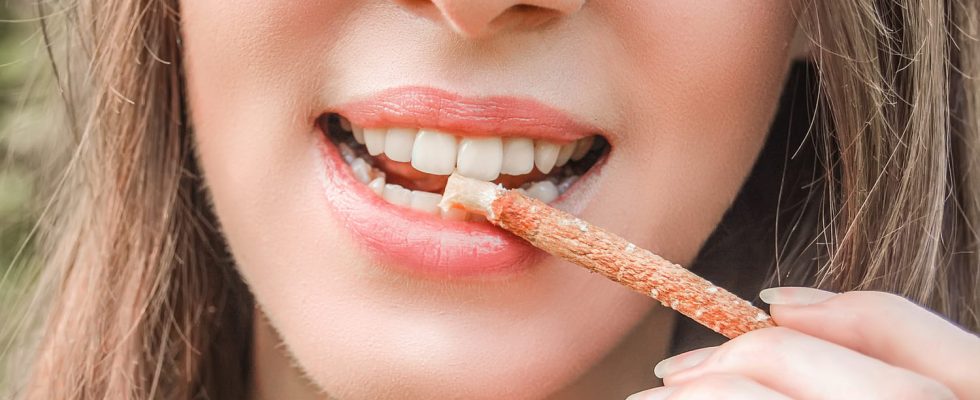The siwak stick could be effective in removing stains and whitening teeth, but “its use is not recommended for everyone” warns our dentist.
Siwak (or miswak) comes from the root of the shrub Salvadora persica. It is a small stick made of flexible fibers which can be used as a natural, ecological and economical toothbrush because it does not require toothpaste. Siwak has been used for centuries in African and Middle Eastern countries, but in recent years it has been developing in Western countries such as France. We do not find examples of this in the organic stores.
How is siwak used?
→ At first use, soak the end of the siwak stick in a glass of water for 15 minutes. The fibers will then soften and resemble toothbrush bristles.
→ Once the fibers have become flexibleplace the stick at the top of the tooth (at the gum line) and gently rub in small circular motions to the bottom of the tooth, without toothpaste. Repeat this action on all your teeth. It is possible to clean your tongue by gently passing the stick over it.
→ After use, rinse the siwak under water and let it air dry in an upright position. Use 2 to 3 times a day for 2 minutes.
→ When the fibers are damaged – approximately every two days – cut the end of the stick then cut the bark 2 cm to release new fibers. Repeat the step for the first use. After 2 weeksthrow away the stick and get a new one.
A natural solution for whitening teeth?
Siwak sticks have several active ingredients which are released during brushing, when mechanical crushing of plant fibers. Among the active ingredients, there are silica which acts as an abrasive and which helps remove stains and whiten teeth. “To summarize: silica is sand. SO the anti-stain effect is obtained by “exfoliation”. Silica will polish the enamel, which can ultimately thin the protective shell of the tooth too much if the use is intensive. We are therefore not going to recommend a product that is too rich in silica. (this is the case for certain toothpastes sold to “whiten teeth”) for daily use, but in the case of siwak, the silica content does not seem to be problematic“, warns Dr. Vallory. Again, from time to time, we can possibly take advantage of the natural silica content of siwak to “maintain a small scrub of your teeth without a significant abrasion effect“. Brands like Ayurvenat, Comme Avant or Kerala Nature offer Ayurvedic toothpastes (in tube or solid) based on siwak powderbut “generally, these are products based on siwak extracts, and their fluoride content is very, very weakSO they are not recommended“, points out our interlocutor.
As effective as a toothbrush?
On paperthe siwak seems to be a good alternative with a toothbrush. L’World Health Organization even approves its use. In 2006, the WHO conducted a study on 56 people (18 women and 38 men) aged 20 to 60 to evaluate the effectiveness of siwak sticks on the elimination of dental plaque for one week. At the end of the follow-up, the researchers concluded that the siwak, when used correctly (for at least 2 minutes), was as effective as a conventional toothbrush in removing plaque from the oral surfaces of the teeth. Additionally, none of the participants complained of discomfort or showed inflammation of the gums when brushing their teeth with siwak. However, “let us not forget that the WHO has a global vision of public health and takes into account the diversity of countries. For some Third World countries especially those who do not have access to hygiene tools and oral care, the siwak has a real interest. On the other hand, in Western countries like France, siwak cannot be recommended replacing a conventional toothbrush“, insists Dr Alain Vallory, dental surgeon and Secretary General of the Dental Surgeons of France:
“The toothbrush is clearly superior in terms of effectiveness”
► In terms of composition, the siwak might seem interesting. “The stick naturally contains an alkaloid (antibacterial), fluorine, silica (abrasive) and a certain number of vitamins and minerals including vitamin C, calcium, phosphorus. This composition roughly corresponds to what can be found in toothpastes. The only criticism that can be made about the composition is that the dose of fluoride in the siwak is weak (1 μg/g, i.e. the recommended dose of fluoride for children whereas adults with an average caries risk need 1.5 μg/g). However, the fluoride is essential to strengthen the enamel and make it more resistant to cavities given our Western diet“, explains our interlocutor. This is therefore not sufficient for adults who have an average caries risk and even less for those who have a high caries risk.
► In terms of use, it’s more problematic. “The tooth generally has a rounded shape and needs to be brushed/cleaned 360°. If the siwak stick can effectively brush the outer surface of the teeth, its straight shape and length do not allow the internal surfaces of all teeth to be properly brushed, on the tongue side and palate side. Therefore, there is no photo: the toothbrush is clearly superior in terms of effectiveness“, he emphasizes.
In conclusion, we cannot recommend the use of siwak as a replacement for a toothbrush, especially if you have a high caries risk or suffer from loosening teeth because siwak can be very aggressive for gums that are already weakened. Aside from the risk of caries or tooth loss, you can use it occasionally, when you are traveling or do not have access to a traditional toothbrush. “If you master the technique, it’s always better than nothing at all.”.
- WHO – The effectiveness of chewing stick miswak on plaque removal – Saudi Dental Journal, Volume 18, No. 3, September – December 2006
- Almas and Al-Zeid, “The immediate antimicrobial effect of a toothbrush and miswak on cariogenic bacteria
